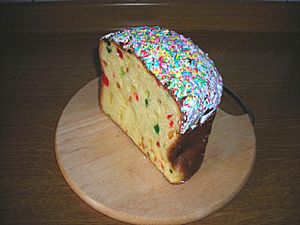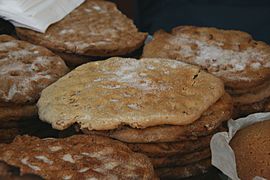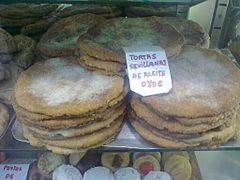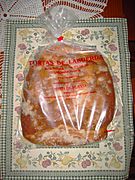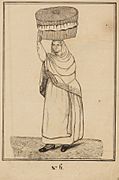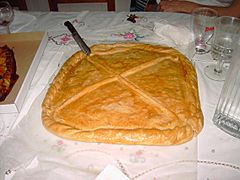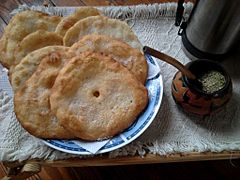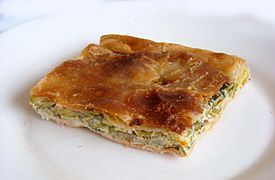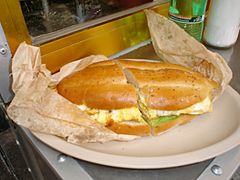Torta facts for kids

Torta cenceña made in La Roda
|
|
| Type | Flatbread, cake, sandwich, or omelette |
|---|---|
| Place of origin | Spain, Mexico, Italy, Malta, Slovakia, Bosnia, Croatia, Sweden, Albania |
A torta is a food term that means different things in different places! Depending on where you are, a torta could be a sweet cake, a flatbread, a sandwich, or even an omelette. It's a word used in many countries, especially in Spain, Latin America, and the Philippines.
Contents
What Does "Torta" Mean?
The word torta comes from the Spanish language. It originally came from a Latin word meaning "twisted bread." The English word "tart" is actually related to it!
Torta as a Cake
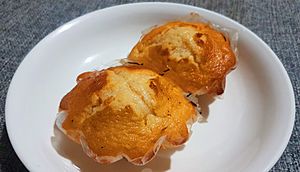
In Spain and some parts of Latin America, torta often means a sweet cake. Think of a wedding or birthday cake. Other European languages also use similar words for cake, like the Italian torta or the German torte. In Mexico, sweet cakes are usually called pastel.
Cakes in the Philippines
In the southern Philippines, especially in areas like Visayas and Mindanao, torta usually means small cakes. It often refers to mamón or torta mamón. This is a soft, spongy cake that looks like a big cupcake. It's often topped with butter, sugar, or cheese. People traditionally eat it with sikwate, a hot chocolate drink, for an afternoon snack.
Cakes in Europe and the Middle East
In many European countries like Hungary, Slovakia, Italy, and Sweden, torta means a cake. These cakes often have layers of sponge cake with cream, chocolate, or fruit fillings. In Arabic, all kinds of tarts are also called torta.
Torta as a Flatbread
In Spain, torta first meant different kinds of flatbread. Some of these, like the torta de gazpacho and torta cenceña, are still made today. Historically, a torta was different from regular bread because it was round and flat. It also used baking soda or powder to rise, instead of yeast.
People used to think of torta as a simpler kind of bread. There's a Spanish saying:
|
|
This means that if you don't have regular bread, tortas are a good substitute!
Flatbreads in Latin America
In Uruguay, Argentina, and parts of Chile, there's a fried flatbread called torta frita.
Torta as an Omelette
In the northern Philippines, especially where people speak Tagalog, torta means a type of omelette. These omelettes are made with eggs, and sometimes include ground meat (like beef or pork) or vegetables.
There are many kinds of Filipino tortas:
- Tortang giniling or tortang picadillo is an omelette with ground meat and cooked vegetables.
- Tortang gulay is an omelette with peppers, mushrooms, onion, and garlic.
- Tortang talong is an eggplant fritter, which is like a fried eggplant omelette.
- Tortang okra is an omelette with thinly sliced okra, onion, and garlic.
In Spain and Latin America, a Tortilla de huevo is a small fried mix of scrambled eggs, often eaten in a sandwich.
Torta as a Pie
In Italian, torta simply means cake, whether it's sweet or savory. However, in Italian-American communities, it can mean a pie. An Italian torta is different from a crostata because its filling is smooth and blended, not chunky.
Italian torta is a pie that can be like a quiche, often served for brunch. Its crust is usually made of cheese or pizza dough. The fillings can vary, but traditional Italian torta often includes ricotta cheese, Parmesan, parsley, and onion. Some versions have meat, while others are vegetarian, sometimes with artichokes.
Pies in Other Countries
In Brazil and other Portuguese-speaking countries, torta means a pie that can be sweet or savory. In Malta, torta also means a pie, which can be sweet or savory. A famous Maltese pie is "torta tal-lampuki," made with lampuki fish. A sweet Maltese pie is "torta tal-lewz," made with almonds.
In Venezuela, Ecuador, Chile, and Uruguay, people usually call dessert cakes "tortas."
Torta as a Sandwich
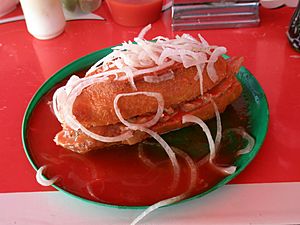
In Mexico, a torta is a type of sandwich. It's served on special white sandwich rolls called a bolillo or a telera. Tortas can be eaten cold or hot, and they can be grilled or toasted.
Common toppings include avocado, chili peppers (like poblano or jalapeño), tomato, and onion. Tortas are very popular all over Mexico. In northern Mexico, they are sometimes called lonche, which comes from the English word "lunch."
The sandwich is usually named after its main filling:
- Torta de jamón means a ham-filled torta.
- Torta de aguacate means an avocado-filled torta.
- Torta de milanesa means a torta with breaded meat.
The torta ahogada (meaning "drowned" torta) from Guadalajara is covered in a red sauce. You can find many different fillings, and sometimes people mix them to create new tortas.
The Torta Cubana is another Mexican torta. It's filled with different meats, depending on where it's made. Don't confuse it with the Cuban sandwich! The Mexican Torta Cubana was named after the street in Mexico City where it was invented, Calle Republica de Cuba.
Because they are easy to carry, tortas are often sold at big events like football games or concerts. You can also find them for breakfast, lunch, or dinner at special shops or from food carts. The exact origin of the torta is not clear, but some believe it started in Puebla, Mexico.
Gallery
-
Torta de chicharrones from Galicia, Spain
-
Tortas de aceite in Seville, Andalusia, Spain
-
Packed torta de huevo, from Sobrarbe, Aragon, Spain
-
Torta frita from Uruguay and Argentina
-
Torta verde from Ventimiglia, Italy
-
Tortas being prepared on a griddle in Oaxaca, Mexico
-
Tortang talong is an eggplant omelette commonly served for breakfast or as a side dish for other meals.
See also
 In Spanish: Torta (pan plano) para niños
In Spanish: Torta (pan plano) para niños


